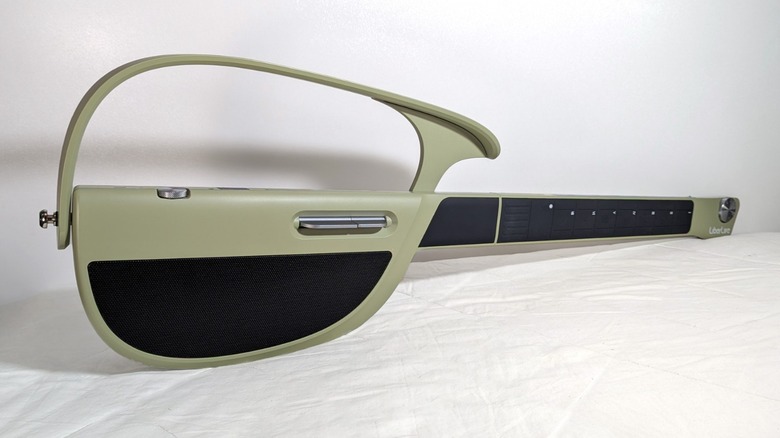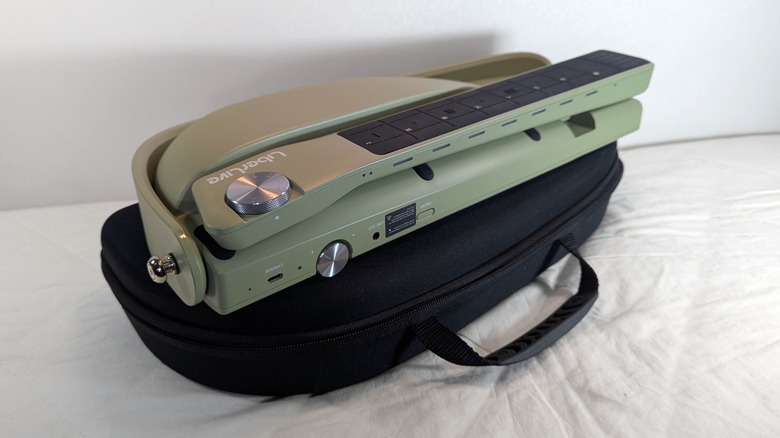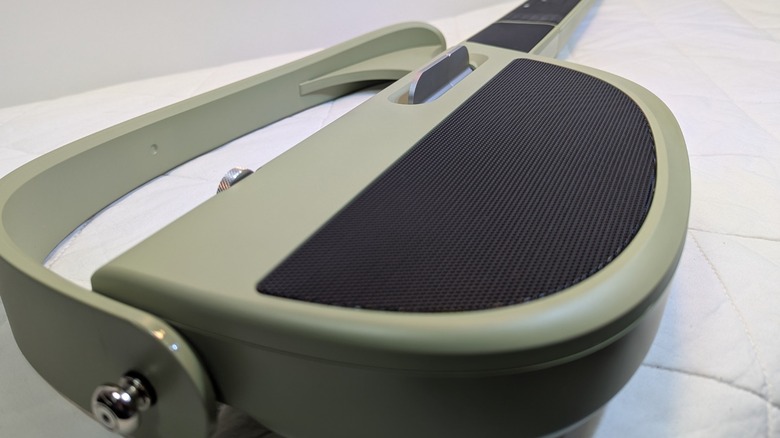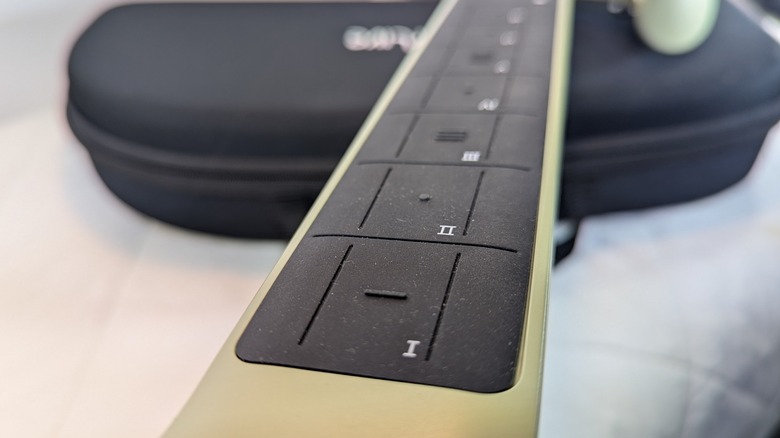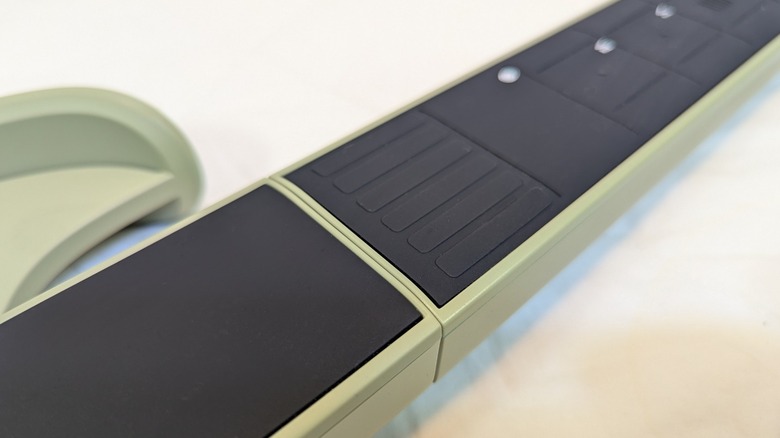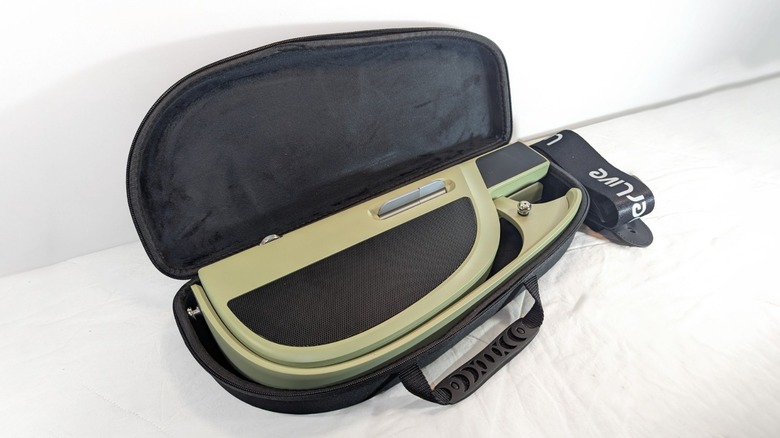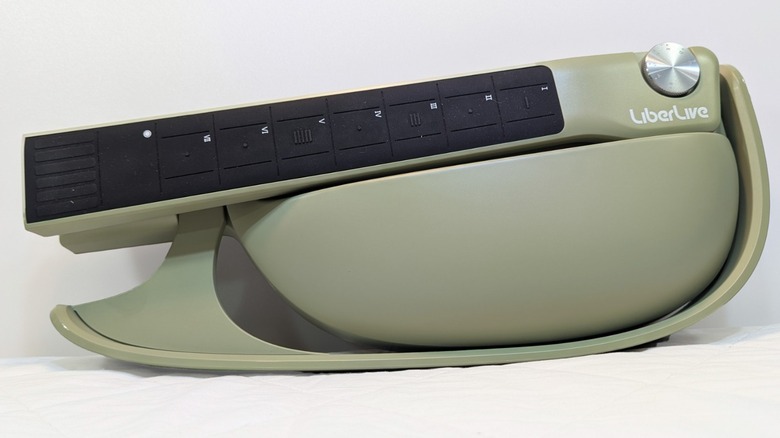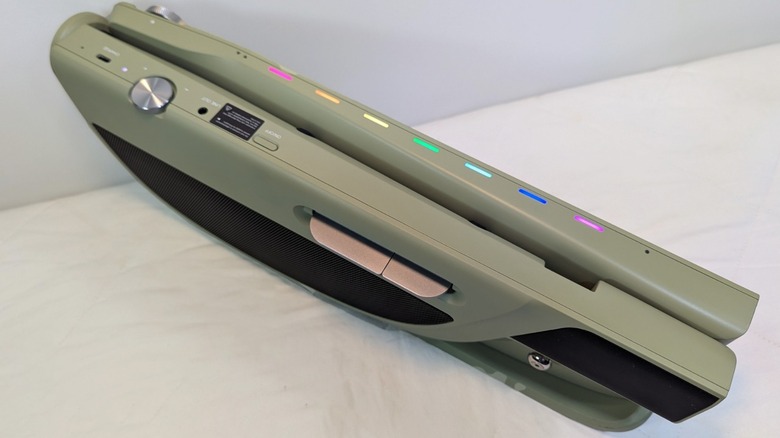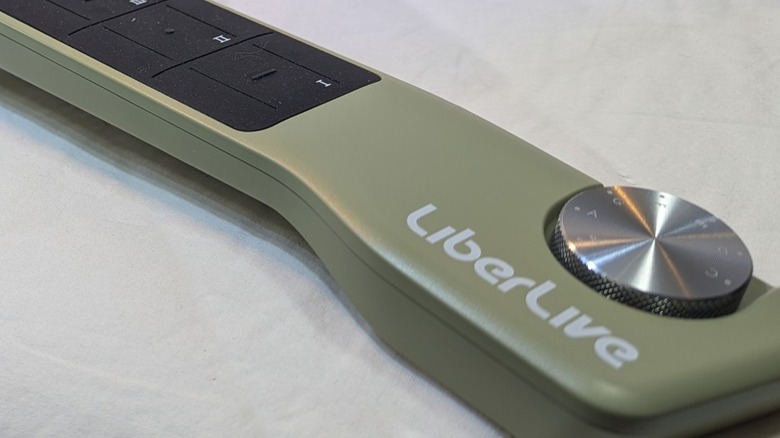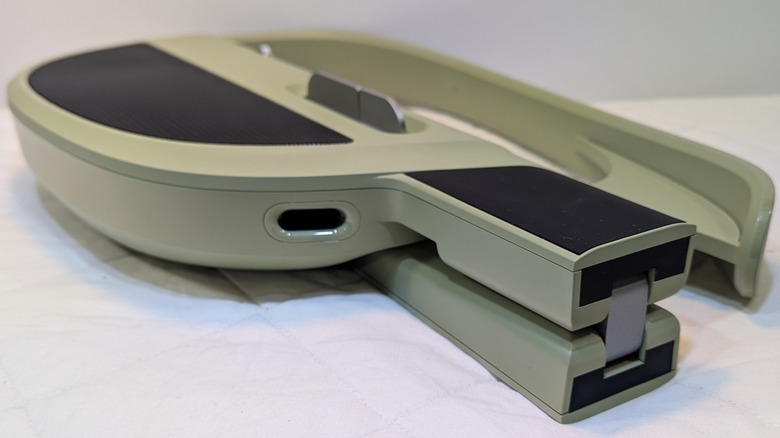LiberLive C1 Review: A Stringless Smart Guitar Looking For A Player
- Excellent build quality
- Great digital sound
- Conveniently portable
- High price (comparable to big name electric guitars)
- Limited capabilities
The building techniques for some of the finest instruments in the world have changed little in the decades or even centuries that've passed since their inception. And while many instrument makers continue to adhere to traditions established long ago, modern technology has provided countless ways to reinvent existing instruments, giving them novel capabilities. This has led to the creation of a stringless guitar, as counterintuitive as that may sound, transforming the instrument into something altogether different and new.
LiberLive claims to have created the "stringless guitar" category of musical instrument when it launched its LiberLive C1 Stringless Smart Guitar in 2023. Maintaining the mission to "Liberate Your Music Live," the company has reimagined the guitar as a fully digital instrument meant for backing vocalists to enhance the experience of live music. Even its name, LiberLive, is a portmanteau derived from the liberation of live music. And while musicians in general may not object to the idea of liberated music, whether an instrument makes the sounds they want in the way they want ultimately matters much more than any philosophizing. To discover if a stringless guitar might actually free any music, LiberLive provided a C1 Stringless Smart Guitar to SlashGear for review, and this is a summary of that discovery.
A guitar without strings?
Yes, the C1 is shaped like a guitar and makes sounds like a guitar, but it is definitely something different. Made to be highly portable similar to other collapsible guitars, it folds up to fit in a durable carrying case a few inches thick and looks like it could carry a small ukulele. You can fold out the neck and flip the half-body frame up and it will then resemble a guitar. From there, you can find more similarities in the neck and fretboard made of touch-sensitive rubber pads, a head with a single dial, and knobs on the end and back for attaching a strap. And that is where the similarities end.
While an electric guitar works by amplifying a resonating string over its pickups, this is fully digital and replacing the strings are a couple of paddles reminiscent of the plastic guitar controllers used with the Guitar Hero video game series. But just to be clear, this is no cheap-feeling plastic toy. All of the controls feel tight, and both dials and the paddles are metal. The build quality is excellent, the instrument has some heft, and its materials all have a feel consistent with quality. It has a solid and professional feel in the way a MacBook Pro feels like well-built and superior hardware. I have to give credit to LiberLive for not skimping on manufacturing as cheaply made instruments do not inspire confidence. Initial impressions are good.
Setup and features
With a traditional guitar, setting up the instrument is relatively straightforward. I would guess that nearly everyone is familiar with how a guitar works, even if they don't know the traditional string arrangement of EADGBE. Once you know that, stringing it up and tuning it is easy. The C1 may be easier at first, but then has a bit of a learning curve. Unzipping the case, the instrument can be pulled out and unfolded. The neck is unfolded before flipping the frame up into position – you'll need to remember the order in reverse when putting it away. You can attach the included strap, but you are finished at that point and ready to play.
The C1 has an onboard speaker in the body of the instrument controlled by a volume knob on the top – it is ported on the side for fuller bass response. On the headstock is another dial used for changing the key like a digital capo. Each fret has a corresponding multi-color LED light, and each fret has three touch points. Higher up on the neck are six bars for strumming one or more strings in a chord, and another touchpad is reserved for activating a drum beat. Aside from the power button and USB-C jack, the only other physical feature is a headphone jack to use for quiet playing or plugging in to an amp or mixer. The C1 is ready to play out of the box, but an app is needed for dynamic control.
LiberLive app
Available on the Play Store and App Store, the LiberLive app is required to get the most out of the C1. All settings for sounds, rhythms, sequences, etc. are controlled by the app, which is connected to the instrument via Bluetooth. The app will prompt you to connect the instrument to your phone and setup and log into a LiberLive account, which has a social media-style element for connecting with other users and sharing compositions.
The rest of the app features several multi-color panels on the main screen used to alter the different patterns and sounds used by the C1. You can control each of the paddles and drum kit as well as tempo and key. When assigning sounds to each paddle, you are not choosing a voice but a pattern. For example, it offers 50 guitar patterns in categories of basic, strumming, and picking. There are also 19 piano patterns, 18 bass guitar patterns, and 10 drum beats.
Also included in the app is a panel for "chord sheets." These are like play along tabs you can use to play popular songs transcribed and shared by users or build one of your own. You can search for songs and find many of the latest artists and a few classics, but not many. In this section is also a tab that brings up tutorial videos, but they are all in Chinese and useless in my case as I do not speak the language. Otherwise, the app is functional and mostly straightforward.
Update: While one version of the app was devoid of tutorial videos in English, a since-updated app now has access to said videos.
Making some noise
If you approach this instrument ready to play melodies or record sequences and new grooves, you will be disappointed. LiberLive appears to be careful to advertise it as a "stringless backing guitar" very intentionally. For each sound you wish to assign to a paddle, you do not get a voice, but a pattern that can be strumming or picking the strings of a chord in one of multiple styles. You may get a bluesy picking or a folksy strumming, but you are locked into whatever strumming or picking that is pre-recorded to play at certain intervals. There is no note-by-note playing.
With the second paddle, you can assign a second guitar, piano, or bass pattern. If you choose similar styles, they can work together, but wildly different styles will sound incongruent. Furthermore, hitting both paddles does not yield simultaneous play. Only one pattern at a time will play, except for the drums. Pressing the drum pad on the neck starts with a fill and then goes into whatever drum beat you have pre-selected in your app. If you want to change up the beats, there are no controls on the instrument, and you have to return to the app, something near impossible to do while playing.
Update: To adjust the BPM one needs to press the drum pad and use the volume to change beats per minute by 5 (up or down). While this isn't entirely obvious from the get-go, it is nice to know that the capability is there.
Finding a key
Songs are played by depressing a fret and strumming a paddle. You can alter which chord you use on different frets, and advanced mode splits each fret into three, expanding chord choices to minor, seventh, and ninth in various arrangements. For example, when you press down on the middle of the first fret when tuned to C, you get C major, with C minor on the top third and C seventh on the bottom third. Change tuning, and the first fret changes with it from C to D to E and so forth.
Playing a pattern in such a way that it sounds decent requires matching the timing and tempo of the strumming, making it sound awkward if you come in early or late, which really limits what you can play with this, particularly if you want to be creative. It functions similar to a rhythm guitar primarily strumming more for rhythm than melody. You can play and keep up with key changes, but you can never be the lead. It is a "backing guitar" after all, so it definitely stays within its lane.
Performing a song
If this all sounds a bit complicated, it really isn't. It may be a limitation of written language in conveying how a stringless guitar, already a foreign idea, is to play. Nonetheless, the goal of playing music is usually to play a song, and that, too, is the purpose of a LiberLive C1. However, this can prove to be a bit frustrating.
As I already mentioned, this is not a lead instrument. Therefore, it is best to think of it as part of the rhythm section, and songs driven by a strong vocalist are best suited. Pick a tempo, set up your paddles and drums, and tap the drum pad to get started. From there, you will need to hit the paddle to "strum" the guitar with your right hand primarily on downbeats while finding the chord with your left. There is no fancy picking or strumming, and depending on which guitar or piano pattern you have chosen, matching the meter of a particular song can be tough and hard to sync logically.
Using the chord sheets should help you play a recognized song, but I had trouble playing anything recognizable as I followed along playing as directed by the app. Ultimately, it works for basic rhythmic strumming either with or without a beat and not much else.
Competitors
LiberLive's instrument is novel in many ways, but the idea in general is not. Casio has a history of portable digital instruments, and it created the Casio DG-10 digital guitar back in 1987. It never went mainstream, but the idea has spread in recent years. The Artiphon Instrument 1 began on kickstarter in 2016 as a digital fretboard, and today, its successor, the Chorda, sells for $249.99. With touchpads, multiple instrument voices, and strumming controls, it works like a digital guitar. The Misa Kitara dates back to 2011 and has since been upgraded to the Quadwave, a digital guitar with a touch-sensitive fretboard that you strum on a touchscreen. For $799, it offers versatility and a unique playing experience. There's also the Aeroband Guitar for $429, which essentially digitizes an electric guitar but does not fundamentally alter the basic concept.
The market for a digital guitar is extremely narrow. Most guitar lovers want to play with real strings and learn to play increasingly harder music, and the idea of making it easy and digital probably turns them off. Others looking for backing accompaniment can also find that in myriad choices of keyboards, synthesizers, and drum machines. This means the LiberLive C1 is up against fierce competition, and its unique and novel features may not be enough to sufficiently lure buyers.
Target Market
Finding the target market for this instrument seems to me where it will fall or stand. As much as the company's website touts music freedom and the limitless nature of it, the C1 is incredibly inflexible. It cannot be used as a lead instrument, you cannot record samples or midi loops, and you cannot program beats, sounds, or rhythms for playback. The only way you can play it is for backing accompaniment.
If you really like to sing, and want to sing songs heavily driven by vocals like those of Benson Boone or Gracie Abrams – or perhaps think Bruno Mars or Sheryl Crow for earlier examples– this could work for you. You would also want to buy an instrument and have no desire to learn how to play guitar, because this does not teach you to play music in any way. With its built-in speaker, I can see it being beneficial to buskers who have a really great voice and want to add something to a performance rather than sing a capella, but that still feels a stretch.
One place I can see this working very well is in church. In places where amateur singers all over the country perform songs every week, with little practice, they could have someone playing along for the congregation or youth group for sing-alongs or other social functions. It would work well for them.
Conclusion
For a retail price of $499, the LiberLive C1 delivers on quality and craftsmanship. The onboard speaker sounds great and delivers a full range of sound at a surprisingly high volume. Furthermore, it produces crisp and clear sounds with fullness and clarity. I don't know if they are sampled or digitally created, but they are done well. The physical product and its related software seems well developed and executed. Playing it is another story.
Having so few ways to play an instrument is stifling for creative people. The inability to create and record music will turn away most professional and aspiring musicians. This leaves people who like to sing and have simple accompaniment to sing to, and I cannot imagine that market is very big, especially given the price. For comparison, Guitar Center carries traditional guitars and electric guitars made by all the major electric guitar manufacturers, and for $499, you can get an Epiphone Les Paul, Ibanez RG470DX, Fender Squier Stratocaster, Guild Surfliner, and around 10 other professional quality guitars. Perhaps I am wrong and there are people who want the kind of hand-holding music playing experience offered by the LiberLive C1, but I still can't see them shelling out $500 to do it.
